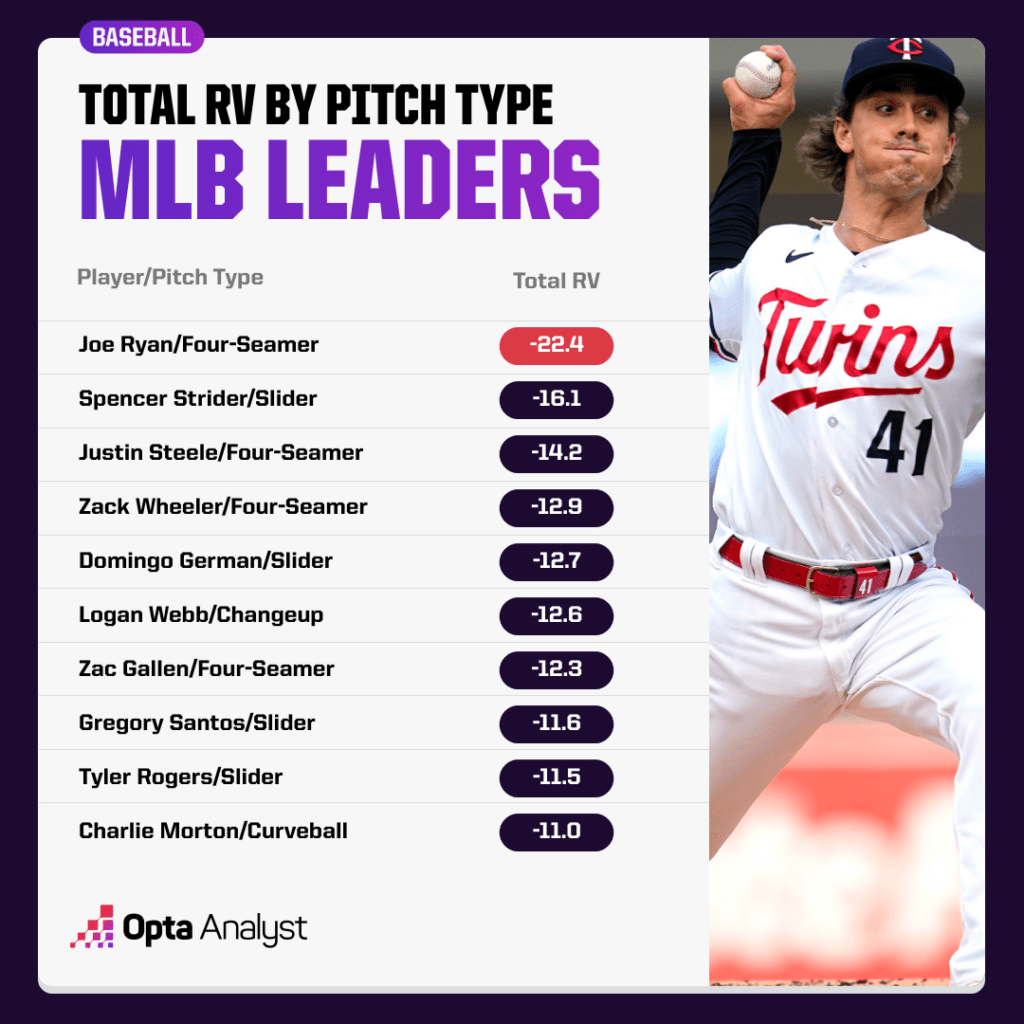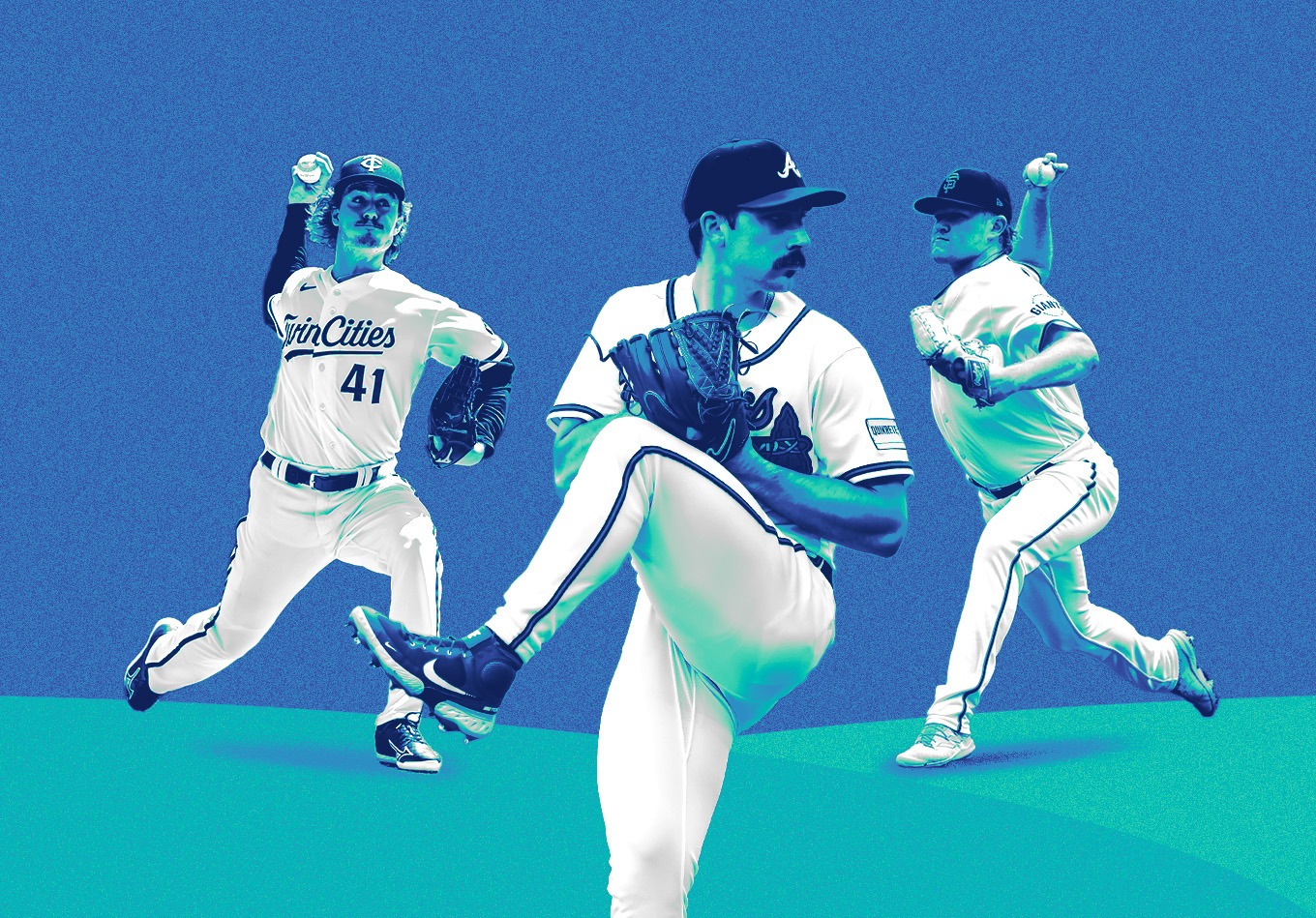With the second half of the season underway, we have more than enough data to name the best individual pitches of the year to this point.
To do that, we’re using raw value (RV), a stat that feeds from elements such as plate discipline, quality and quantity of contact to evaluate performance on a per-pitch basis, as opposed to just looking at the outcome of the at-bat.
The metric assigns value to the different outcomes a pitch has. Those numbers add up through the season, and since it’s a cumulative stat, RV helps us determine who has the best fastball, slider, curveball, two-seamer, and more.
When it comes to pitching, the lower the RV, the better.
We will also use additional metrics such as command+, whiff+, strike+ and BIP+. All of them use 100 as the average performance, and in the case of the first three, higher is better. For BIP+, a stat that examines the quality of contact, lower is better when evaluating pitching.
Let’s take a look at the pitchers who have the most valuable offerings in Major League Baseball for each pitch type this season.
Four-Seam Fastball: Joe Ryan, Minnesota Twins
Ryan is the owner of the most valuable pitch in baseball so far: his four-seamer has accumulated an incredible minus-22.6 RV. It doesn’t max out at 101.2 mph like Jacob deGrom, so how does Ryan have so much success with a 92.5 mph fastball that has middling spin rates?
Travis Sawchik wrote last year that Ryan’s flat vertical approach angle and low release point give him the ideal fastball. The vertical approach angle (VAA) is “the trajectory at which a pitch enters the strike zone as it crosses home plate. The flatter the angle of a fastball, the harder it is to hit because the trajectory stays above a batter’s own swing plane,” per Sawchik.
An ideal VAA is more closely correlated to swings and misses than fastball velocity, so there you have it. Not only do hitters miss a lot when swinging at Ryan’s heater (173 whiff+) but the quality of contact he allows is also elite, judging by his 73 BIP+. Overall, he’s seventh in the American League with 131 strikeouts.

Ryan goes to his fastball 58.2% of the time. Given his rather disappointing 3.77 ERA and how effective his fastball is, one would think he should be using it more.
Next best: Justin Steele, Chicago Cubs (-14.2)
Two-Seam Fastball: Jason Foley, Detroit Tigers
At -7.9 RV, Foley is the owner of the most valuable two-seamer. The curious thing about that is his role: he is a reliever, and RV is a cumulative stat.
The fact he doesn’t start games hasn’t stopped him from pumping two-seamer after two-seamer with huge results. He goes to it 77.1% of the time and it has helped him dominate.
With a 2.23 ERA and a 1.07 WHIP in 40.1 innings with the Tigers, the right-hander has taken a huge step forward this season.
The pitch’s 86 whiff+ might be below-average, but imagine hitting a high-90s pitch with superior arm-side movement. The quality of contact the pitch (some sources call it a sinker) has yielded is optimal for Foley, evidenced by its 71 BIP+.
Hopefully, Foley and his nasty two-seamer start getting the recognition they deserve in no time.
Next best: Josh Hader, San Diego Padres (-7.5)
Cut Fastball: Kodai Senga, New York Mets
Yes, you probably know Senga for his ridiculous “ghost forkball”, which is usually his put-away pitch. The cut fastball, however, is one of the pitches he uses to set that up and it’s incredibly effective with a -10.0 RV.
While Senga’s forkball earns most of the swings and misses (165 whiff+), his cutter generates plenty of soft contact with an absurdly low 6.0 BIP+. It’s one of the big reasons why he has the fifth-lowest opponent batting average in the majors.
While his fastball is his most frequently used pitch, his main secondary offering will depend on the batter’s hand. He favors his cut fastball against lefties and his ghost forkball against righties.
That pitch mix has helped him post a solid 3.20 ERA in 95.2 innings despite having some issues with his control and command from time to time. The All-Star right-hander really is as advertised: his stuff is nasty, and his cutter has been amazing.
Next best: Kenley Jansen, Boston Red Sox (-8.9)
Slider: Spencer Strider, Atlanta Braves
Strider has the second-most valuable pitch in baseball to this point. No, it’s not his fastball – it’s his phenomenal slider. Every great starter has, at least, two excellent offerings and Strider’s slider is somehow underrated.
It looks like this:
The slider’s -16.1 total raw value to this point shows how great it has been. The break is not exactly “late”, but it’s really sharp: the pitch comes so fast that hitters have already decided to swing. It’s often an empty swing, too, with an elite 182 whiff+.
At 33.7%, the slider is Strider’s second-favorite pitch behind his special fastball. He obviously uses it more often against right-handers (40.7%) than lefties (27.6%) and loves going to the offering when ahead in the count.
Strider has a 3.66 ERA, but his 2.83 FIP suggests the former number is about to come down. With that fastball-slider combo, it’s the only logical outcome.
Next best: Domingo German, New York Yankees (-12.9)
Splitter: Shane McClanahan, Tampa Bay Rays
At -7.7 RV, McClanahan is the owner of the most valuable split-finger to this point. Some call it a changeup, but whatever you call it, it’s one of the nastiest pitches in baseball.
Check it out:
Hitters are slugging an incredibly woeful .179 against the pitch. You don’t need us to tell you that’s amazing. They just can’t square the pitch.
Not only does he have an unbelievable 181 whiff+ with the pitch, but he also earns strikes at an incredible rate with it (147 strike+) with it.
The left-hander, one of the best starting pitchers in baseball and an AL Cy Young candidate last season, uses the splitter mostly against right-handers, though. He goes to it 29.6% of the time vs. righties, and only 2.1% vs. lefty hitters. It makes sense given the pitch’s arm-side break.
With a 2.56 ERA in 102 frames, McClanahan is once again one of the best pitchers in the league. His splitter is a big reason why.
Next best: Erik Swanson, Toronto Blue Jays (-7.5)
Changeup: Logan Webb, San Francisco Giants
Fueled by an incredible changeup, Webb is sporting a 3.11 ERA heading into Thursday’s action. The pitch has a very solid -12.6 RV, comfortably the best in the league.
Webb is essentially a three-pitch hurler, so the changeup is a big part of what he does. He throws it 37.0% of the time, and the number goes up to 41.3% against lefties.
With it, Webb generates soft contact (61 BIP+) and even though it doesn’t miss that many bats (113 whiff+), he does whatever he wants with it judging by his excellent 123 command+.
A pitch doesn’t always have to generate an absurd number of swings and misses in order to be highly successful, and Webb’s changeup is the perfect example of that.
Next best: Trevor Richards, Toronto Blue Jays (-10.2)
Curveball: Charlie Morton, Atlanta Braves
To the surprise of absolutely no one, Morton has the best curveball in baseball at -11.2 RV.
The pitch has it all to captivate the eye: it’s fast, has a sharp break, and has been consistently good over time. Its 139 whiff+ and 117 strike+ are both fantastic.
You know off-speed pitches or breaking balls are insanely good when the hurler in question uses it more often than his fastball. This is the case with Morton, who goes with the hook 45.0% of the time against 41.0% with the heater. With two strikes, you can expect to see a curveball more often than not: the split, in that case, is 57-35% as he goes for the kill.
From a run-prevention standpoint, Morton is having his best year since 2019 with a 3.20 ERA. He hasn’t been perfect as his 1.36 WHIP suggests, but he has been getting the job done.
Next best: Blake Snell, San Diego Padres (-9.5)
Sweeper: Justin Lawrence, Colorado Rockies
The sweeper has been increasing in popularity in recent seasons, although it’s not necessarily new. It is similar to the slider but with more horizontal movement, as opposed to a “tighter” break.
Lawrence has the most valuable sweeper in MLB at -9.3 RV. It’s not an elite bat-missing weapon (100 whiff+) but hitters can’t do anything with it (28 BIP+) and he earns lots of strikes with it (119 strike+).
With a 2.57 ERA in 49 frames, Lawrence is finally breaking out and the sweeper is a big reason why. He uses it more against righties but is not afraid to throw it against lefties. His confidence on the pitch has grown – and so has his performance.
Next best: Andrew Vasquez, Philadelphia Phillies (-8.8)/Shohei Ohtani, Los Angeles Angels (-8.2)
Like this? Follow us on Twitter for more.
